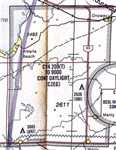A) What classes of airspace are used in Canada?
At the very basic level Canadian Airspace is broken down into controlled and uncontrolled airspace. Within each are different classes.
Controlled Airspace consists of;
|
Controlled Airspace |
Uncontrolled Airspace |
|
Class A |
Class G |
|
Class B |
Class F |
|
Class C |
|
|
Class D |
|
|
Class E |
|
|
Class F |
|
See CARS 601.02
B) In the table above Class F is listed under both controlled and uncontrolled airspace. Why?
Class F is called "Special Use" and is used for many purposes (see the legend on your VNC map for a list of them). Depending on it's use class F will take on the rules of another airspace. See
CARS 604.04
C) Using the map below and the
Designated Airspace Handbook in this link found out:
-
What this Class F is used for,
-
What class of airspace rules must be used,
-
What times the class F is operational,
-
If the class of airspace changes, what time does it change..

Click to Enlarge
From the map you can see that this class F is advisory (CYA) which means if you are VFR you may enter at your own discretion, even when the area is active. It also shows the area is used for training denoted by the (T). For the the rest of the information you need to find CYA 209(T) in the designated airspace handbook (page 173).
As you can see this area is operational everyday during daylight hours. During the day it is uncontrolled class G airspace from the surface up 9000 feet Above Seal Level. At night it the airspace rules to used are whichever surrounds it. If you have an Edmonton VTA handy you can see it is Class G below 3400 feet ASL, Class C between 4600 to 12,500 feet ASL.
D) If your flying and you see a forest fire what Class of Airspace is it and what are the dimensions?
It automatically becomes Class F Restricted. The standard dimensions for the airspace are a radius of 5 nm and from the surface to 3000 feet Above Ground Level. Be aware that this is only the standard though and it can be changed via a NOTAM. See
CARS 601.15
E) What class(es) or airspace are you required to have a transponder?
You must have a transponder in all Class A,B and C airspace. In addition some Class D and E will also require a transponder and will be listed as such in the Designated Airspace Handbook. See
CARS 601.03